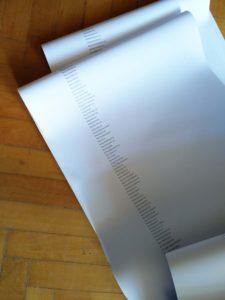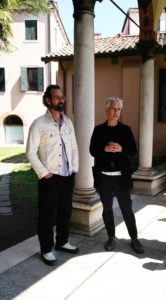 This years’ pavilion of New Zealand of the 58. Venice Biennale in the Palazzina Canonica is housing an installation by Dane Mitchell. The exhibition is curated by Dr Zara Stanhope and Chris Sharp. The heart of the work is an inventory of over two million items, naming bygone phenomena, ranging from dead words to extinct species, ghost towns, former nations, lost artworks and more. Visitors can listen to the list being read at the venue or they can be received through the visitor’s mobile device, when close to one the transmitters across the city. Additionally, the words are printed during the presentation. Dane Mitchell clarified his intervention for us.*
This years’ pavilion of New Zealand of the 58. Venice Biennale in the Palazzina Canonica is housing an installation by Dane Mitchell. The exhibition is curated by Dr Zara Stanhope and Chris Sharp. The heart of the work is an inventory of over two million items, naming bygone phenomena, ranging from dead words to extinct species, ghost towns, former nations, lost artworks and more. Visitors can listen to the list being read at the venue or they can be received through the visitor’s mobile device, when close to one the transmitters across the city. Additionally, the words are printed during the presentation. Dane Mitchell clarified his intervention for us.*
Astrid Gallinat: Post Hoc is hosted at the Palazzina Canonica, the Instituto di Scienze Marine (the former headquarters of the Institute of Marine Sciences of the National Research Council of Italy). How does the location fit into your artistic concept?
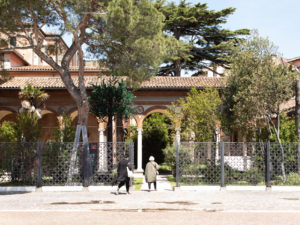 Dane Mitchell: New Zealand does not have a permanent pavilion at the Biennale Arte, so each exhibition we are able to choose a venue best suited to the work.
Dane Mitchell: New Zealand does not have a permanent pavilion at the Biennale Arte, so each exhibition we are able to choose a venue best suited to the work.
Having the work at the former headquarters of the Instituto di Scienze Marine was dependent on a partnership with that organisation. In this way, the Institute assisted with some research into lists related to the marine environment, but more so, it was a poetic partnership. The ocean is a liquid repository for the vanished: it is a mysterious depth — a mass that we most often encounter as a surface. It is also a zone as (in parts) unknown to us as deep space and constantly the source of new knowledge.
It is a place in which we project our imaginings of the unknown and our notions of vastness, whilst also being at risk: a place always on the brink of potential loss.
Listen to an extract of the list of lists, courtesy New Zealand at Venice.
A.G.: During two years you and your team collected phenomena, all vanished from the world today. The huge list is subdivided in 260 categories. It is read with a rate of over 10.000 words during eight hours per day. Why have you chosen to focus on items, which no longer exist?
D.M.: It’s actually more like 15,000 words a day, as an average, and it should be noted that there are no people named.
Post hoc seeks to symbolically re-materialise unseen, vanished and defunct phenomena in the present through a speech-act by calling them momentarily into the present — to conjure them — by way of an utterance.
I was drawn to thinking about unseen forces that have real bearing on our lives. I’ve been interested in activating the unseen in my work for some time, as I recognise it as having a political, philosophical, physical, aesthetic and cultural weight — and it is often taken for granted. I was interested in thinking about both the physical and philosophical weight of all of these gone ‘things’.
A.G.: Regarding extinct species or lost artworks, one might think the inventory is a nostalgic review. Are there also positive aspects in the disappearance of some phenomena?
D.M.: Since these lists also include such things as cured diseases and obsolete scientific theories, they are not necessarily reproaches against humanity. They are too varied and complex to be assigned to a singular cause. Nevertheless, they testify to a growing lack of faith in the notion of progress, whose history looks a lot more like a history of obsolescence.
Post hoc questions the connections between events and vanished ‘past things’ — all of these spoken-materials are in a state of being ‘after’. The project asks what our relationship might be to these things that have disappeared – lists of the vanished and bygone things of this world – and what our responsibility to this information is.
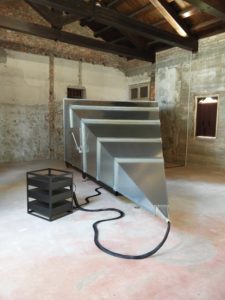 A.G.: The inventory is read by an artificial voice. Was the motivation to create the reading voice by a computer only due to the feasibility or does the artificial sound refer to more?
A.G.: The inventory is read by an artificial voice. Was the motivation to create the reading voice by a computer only due to the feasibility or does the artificial sound refer to more?
D.M.: Seven industrially produced cell towers (designed to be camouflaged as trees) act as the transmitters of the read lists. In much in the same way these forms are surrogates for nature, the synthetic voice is a surrogate for us.
I was drawn to the possibility that the artificial voice offered a way for the reading to be indifferent to the listener: it continues regardless of us listening, or speaking for that matter.
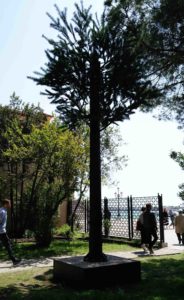 A.G.: The reading is broadcasted to industrial produced tree cell towers whilst simultaneously being read within an anechoic chamber. However, no sound escapes the generally in sciences used lying frustum. Nearly at the same time as the words are broadcasted to the loudspeakers, they are printed in the library. For your installation, you are mainly using prefabricated objects: the tree cell towers, the anechoic chamber and the printer. Do they have a transcending background besides their pure function in the presentation?
A.G.: The reading is broadcasted to industrial produced tree cell towers whilst simultaneously being read within an anechoic chamber. However, no sound escapes the generally in sciences used lying frustum. Nearly at the same time as the words are broadcasted to the loudspeakers, they are printed in the library. For your installation, you are mainly using prefabricated objects: the tree cell towers, the anechoic chamber and the printer. Do they have a transcending background besides their pure function in the presentation?
D.M.: I’m not sure I understand the question: a transcending power? Perhaps I’ll just say that for me it was important to use existing technologies: to work with ‘things’ that exist in the world, i.e. to encounter ‘things’ that humans produce.
Thingness has the ability to be autonomous, yet contradictorily exposed to accumulation — gathering meaning and associations to itself — just as I think occurs through mobilising existing things-in-the-world. In this way thing has the ability to act like a gestalt, amounting to more than the sum of its parts and containing more information than is perceived or presented. Lorraine Daston analysis is useful in imagining “the thingness of the thing lies in its power to ‘gather’ other elements to it: the humble jug gathers to itself heaven and earth, mortals and immortals” (Daston, L. (2004). Introduction. In L. Daston (Ed.), Things that talk object lessons from art and science (pp 9–24). Massachusetts: Zone Books.)
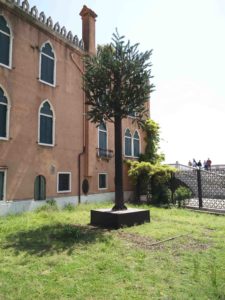 A.G.: Besides the three trees in the garden of the estate, there are four more throughout the city. Why are you distributing the inventory of bygone things throughout the city of Venice?
A.G.: Besides the three trees in the garden of the estate, there are four more throughout the city. Why are you distributing the inventory of bygone things throughout the city of Venice?
D.M.: I was thinking about signals. All ‘things’ produce signals, be they concepts, ideas or ideologies.
I was thinking about the way objects, specifically sculptural objects can be read as transmitters of signals. This idea comes from George Kubler’s 1962 text The Shape of Time, Remarks on the History of Things, in which he makes the poetic suggestion that astronomers and historians have several things in common.
Both are concerned with appearances noted in the present but occurring in the past (as in the way light takes millions of years to reach earth, and in the way historians deal with objects from the past) and he goes on to suggest that both astronomers and historians collect ancient ‘signals’ — from objects and starlight alike. What was interesting for me was to think about an object (a sculpture in the Venetian landscape) as being the transmitter of a signal — a real and metaphorical signal — that is, something that produces a signal which is transmitted into the world that creates perturbations in a field of experience. What also seems really interesting is how this allows for a way to think about a sculptural work of art as an ‘event’, because transmissions are temporal sequences and signals are emanations from time past, produced in the past but experienced ‘now’ (whilst reading the names of things past, vanished, withdrawn and gone), just as every sculptural object is produced in the past but experienced in the present. It became a way to think about a work that might be both a time-travelling event and an object at the same time.
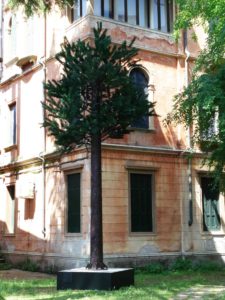 In another way these dispersed ‘trees’ become nodes in a network. They operate as a (visual and transmitted) contagion across the landscape. These rather antagonistic objects doubly affects the environment: they infects the landscape with an object which, in an attempt to go unseen, whilst also producing a transmitted signal that is everywhere and nowhere, spreads itself across the cityscape.
In another way these dispersed ‘trees’ become nodes in a network. They operate as a (visual and transmitted) contagion across the landscape. These rather antagonistic objects doubly affects the environment: they infects the landscape with an object which, in an attempt to go unseen, whilst also producing a transmitted signal that is everywhere and nowhere, spreads itself across the cityscape.
A.G.: How have you chosen the four external listening points?
D.M.: This was by way of very careful negotiation and the generosity of the hosts. Each location connects to Post hoc in real terms. I am trying to cover as much terrain as possible, so extending outwards across the city as much as possible was important, as was it a way for me to imagine opening up parts of the city that are lived in rather than visited.
The hospital is of course an important node in any city. The Hospital in Venice is entered through the incredible Scoula Grande Di San Marco, the facade of which Canaletto painted several times. A hospital is also a place in which the unseen (to the naked eye) is hyperactive (I’m thinking here of the microbial, of disease) and given the project is specifically looking at naming things, a hospital is where people are named, and it is a context in which mortality is confronted, so it is a place of disappearance in some sense.
The school of architecture also host a tree in Dorsoduro. This stealth cell tower takes us to the edge of the city, so in that way it extends the network in a very meaningful way. The lists of names that are at the centre of the project are a subjective imagining of that which is lost, absent, vanished and gone and I was interested in connecting to a place of speculative thought, which one hopes happens at a university.
The cell tower in St Elena is aptly situated in a park named the Park of Remembrance. This could not be more fitting. It’s also a park of pine trees, and so the stealth cell tower attempts to hide amongst its own species.
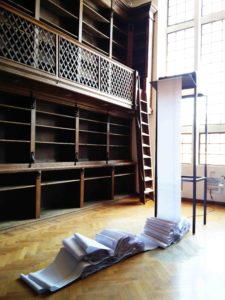 A.G.: In the library are no books. Instead, there is the printer on a high scaffolding. There will be 20 kilometre of paper filling the room at the end of the Biennale. In consequence, inventory of bygone phenomena will be materialised for a last time and the room will be again filled with paper. How will it look like? Will the paper be rolled and stored in the bookshelves or will it fill the space disordered as it is printed?
A.G.: In the library are no books. Instead, there is the printer on a high scaffolding. There will be 20 kilometre of paper filling the room at the end of the Biennale. In consequence, inventory of bygone phenomena will be materialised for a last time and the room will be again filled with paper. How will it look like? Will the paper be rolled and stored in the bookshelves or will it fill the space disordered as it is printed?
D.M.: The paper naturally falls like liquid from the printer. It will simply accumulate and fill the space over time. It will not be stacked or ordered, but will simply unfurl.
A.G.: What will happen to the printed list after the Biennale?
D.M.: Yet to be decided!
A.G.: Thank you very much for your answers!
* Dane Mitchell answered via e-mail.
Thanks to Lizzi Rowles from Flint Culture for getting us in touch with Dane Mitchell.
Photos © Astrid Gallinat & Stephan Goseberg, if not mentioned otherwise

